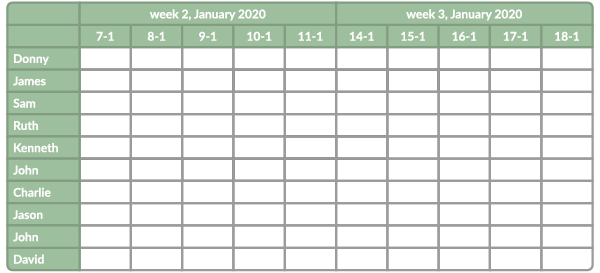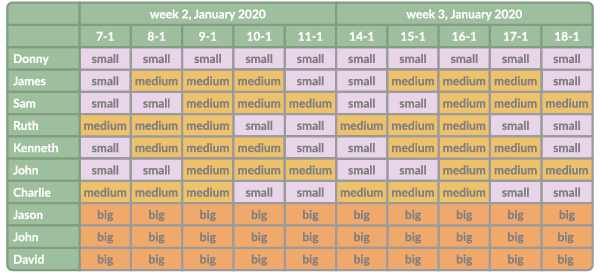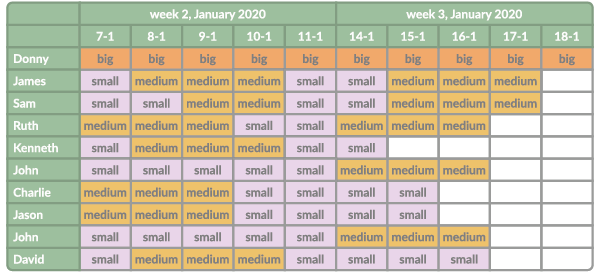And ensure flexibility in planning.
If you look at the picture, you might be thinking there are more stones and sand in the first jar than in the second jar, but nothing could be further from the truth. The second jar contains the exact same amount of sand and stones, only the content doesn’t fit in the first jar. That has to do with the order of filling the jar. If you first fill the jar with the large stones, then the smaller stones and the sand is easier to add.
Maybe you have recognized this principle already. It is one of the principles from the book, The 7 habits of highly effective people by Stephen Covey. It concerns Habit 3: Put first things first or ‘do the most important things first’. By giving priority to the important things in your life, you will succeed in achieving your goals and yet also be able to control all the side issues. If you first focus on the side issues, the important things will suffer. This is very well portrayed in this picture. Watch this video too.
Application in planning
This principle is also perfectly applicable in planning. The jar represents the available employee capacity. If we for instance prepare the planning for an advertising agency with 10 full-time employees for the coming 2 weeks, we have available capacity of 10 x 5 days x 2 weeks = 100 days, as displayed in a planning board below.

If we look at the work, in practice you see it often consists of:
- A few big projects
- Multiple medium-sized assignments
- Lots of small jobs
Let’s just assume a proportional relationship between the different types of work. So for the next 2 weeks, for all three categories, we need around 33 man days to complete the work. If we apply the principle, then we get a schedule as shown in the following figure.

Our starting point is that the work should be completed in one go and that we cannot break the ‘stones’ up in multiple pieces. There are 3 big projects planned first, each of 10 days. Then, there are 12 medium-sized projects scheduled every 3 days. Finally, the rest of the available capacity is filled up with all the small 1 day jobs.
Simple, right? Could be, but in practice there are often factors which make the planning a bit more complex than simply filling a jar with stones and sand.
Complicating factors in practice
The work comes in in drips and drabs
In the Stephen Covey theory, all things are known beforehand. In planning practice, however, we see the work comes in bit by bit. This of course very much depends on the nature of the work and the industry, but you do not always immediately have an idea of all the work and its extent. And you also have no idea of the relationship between big projects, medium-sized jobs and small jobs.
In this situation, to start planning all the work coming in, right away, could be a pitfall. It is often tempting to plan quickly, because that makes you feel good, because you are in control. But if it turns out the additional work no longer fits in because you have allocated the work insufficiently, you shoot yourself in the foot. In the figure below, the other 2 big projects in the earlier example no longer fit and the planning has to be made again.

Fixed agreements
In addition to the fact that the work comes in bit by bit, customers often require a ‘fixed’ agreement on the delivery date of the work. If we plan the big projects first, it’s not so difficult to immediately agree on a fixed date. The issue lies more with the medium-sized jobs and small jobs. Just like the small stones and the sand, you would like to spread that a bit in the jar so everything fits in well. If you are going to fix this with a fixed delivery date to the customer, you lose that flexibility.
The same problems play a role with jobs that you have to carry out at the customer’s site. You really have to plan these well. You can’t get away with announcing on short notice that you will stop by because it is most convenient for you.
Recommendations
1. Wait a bit with the planning
Try postponing the planning for the coming period until you have the best possible picture of all the work that must be scheduled. This will of course differ per company. Some companies are able to plan ahead for months while other companies can only plan a week ahead. Determine which cycle and planning horizon works best for your company with the aim to gain insight into at least 80% of the work for the coming period.
2. Under promise and over deliver
Try to make as few fixed arrangements for the medium-sized jobs and certainly for the small jobs as possible. As you can reschedule these jobs, you have room to adjust your schedule. If you can’t get out of making fixed arrangements for the delivery, rather provide a later delivery date. Thus you maintain the flexibility to push the work backwards, without having to adjust the customer’s expectations. If everything runs according to plan, you will be delivering earlier than expected, as far as your customers are concerned. And they will be happy too.
3. Plan your employees’ full capacity one by one
If you have a large project, you can easily fill the planning for an employee for the coming period. But if you still lack large projects and you first have to schedule the medium-sized and small jobs, do not divide this evenly over all employees. For many companies, this feels very unnatural because they would rather have everyone doing a bit of work than having a few employees very busy while others have nothing to do. I am in favor of distinguishing between employees whose schedules you reserve to be fully planned with big projects, while your other employees do all the small jobs. This gives more flexibility.
The key word in the recommendations is ‘flexibility’. Make sure you are flexible because then you as a company can work with your employees as best you can on all assignments. This increases productivity and immediately leads to higher turnover and profits.





